Although traditional books provide a wonderful way to experience the written word, 21st century reading goes beyond linear stories on paper. Young people have many choices for experiencing a story.
Young people want to share their reading experiences by imagining the characters and sharing this images on social networks such as Deviant Art. The Hunger Games is a good example. There's both a book website and a Facebook connection where readers can watch videos, play games, participate in polls, and hold discussions.
Publishers are increasingly exploring ways to engage readers beyond the printed page. They are designing reading experiences that go beyond the book. Scholastic has been a leader in web-based book connections such as their Flashlight Readers activities like The Underland Chronicles.
Beginning Readers. Books for children are adding multimedia elements such as music, interviews, video, and games to accompany books.
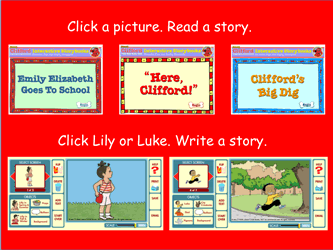 Go to the Turtle Pond Collection website and explore the following books with multimedia elements including images, music, movies, activities, interviews, and games.
Go to the Turtle Pond Collection website and explore the following books with multimedia elements including images, music, movies, activities, interviews, and games.
Sometimes advertisements and an overload of options can distract children. Create a fluid enivronment for reading and writing. Go to the Clifford example. This was created as a PowerPoint slide using screen captures and hyperlinks. The slide was then exported as a web page. Students read stories, then write stories.
Click the image on the right to explore the assignment.
Intermediate Readers. Books for intermediate readers are also entering this new type of reading experience. Rather than being supplemental, the elements are woven throughout the reading experience.
Go to ExpandedBooks.com and explore the Children's section for videos. Then, explore the Clockwork Three website at Scholastic. Create and share your own book trailers at YouTube, SchoolTube, or Vimeo. Use Zamzar to download examples.
Young Adult Readers. Whether reading a new book or a classic like Little Women, young people view reading as a social activity with connections to various devices like the Kindle, iPad, and iPhone.
Go to the Louisa May Alcott: The Woman Behind Little Women website. Explore the background information, trailer, timelines, and lesson plan. See how you connect traditional literature with new technology such as reading on the Kindle, iPad, or iPhone. Watching video at YouTube. Sharing on Facebook, Flickr, and GoodReads. Exploring information at PBS.
Go to the What Would You Wish For website. Read Wish by Alexandra Bullen. Watch the book trailer. Participate in social community where people share their wishes.
Books for young adults are extending their reach beyond multimedia elements and incorporating social media such as Facebook and mobile technology. These books are sometimes called interactive fiction.
Sean Stewart (the author of the Cathy's Series) calls this shift from passive to active reading "the fourth wall." He views this fourth wall as the barrier between the audience and the stage. With the Internet this wall can be blurred or erased. The audience can become part of the play. He notes that young people want to experience Hogwarts, Narnia, and Middle Earth, not just read about them. Whether you're referring to Harry Potter Lego bricks or gaming. Read more in his article and videos on Interactive Fiction.
Jordan Weisman (co-author of the Cathy series) also develops online games for teens that immerse them in virtual worlds including Nanovor Evolution.
Transmedia Readers. Transmedia storytelling occurs when readers seamlessly move from technology to technology experiencing and sometimes participating in the story. These transmedia experiences may include both fiction and nonfiction environments. Read the nonfiction book True Spirit: The True Story of a 16-Year-Old Australian Who Sailed Solo, Nonstop, and Unassisted Around the World on paper or ebook for Kindle. Watch the videos throughout the book. Go to Jessica Watson's website. Track Jessica's Voyage on a map.
Visual Communication. Increasingly, online news agencies are presenting information through innovative approaches. Go to the Sun-Sentinel's The Edge area to explore games, interactives, data center, illustrations, widgets and other new approaches to information dissemination. Examples: Hurricane Maker, Hurricane Interactive, Toy Recall Database, Fossil.
To explore more of these types of environments for reading, go to the Divergent Convergence: Learning in a Transmedia, Multiplatform World article. Also read my article in the October 2010 issue of Teacher Librarian.
Think! Explore the website Patrick Carman website. He's currently the most popular transmedia author. The website is dynamic to encourage ongoing participation through a blog that's constantly updated, polls, and forums for discussions on topics both directly and indirectly related to the book. Social networking aspects including Facebook, Twitter, YouTube. Participants can share pages through Facebook, Twitter, Myspace, and Digg. Participants can sign-up for a newsletter.
I Am Number Four. Explore the official book website including Author information, Characters, The Lorien Legacies, News, Activities.
![]()

 Unfortunately National Geographic, PBS, and BBC haven't developed a program for everything you teach. Sometimes it's necessary to create your own fluid environments. Rather than simply providing a list of resources, consider innovative ways to present information and resources to students. Also, give young people the opportunity to create fluid environments that others can explore.
Unfortunately National Geographic, PBS, and BBC haven't developed a program for everything you teach. Sometimes it's necessary to create your own fluid environments. Rather than simply providing a list of resources, consider innovative ways to present information and resources to students. Also, give young people the opportunity to create fluid environments that others can explore.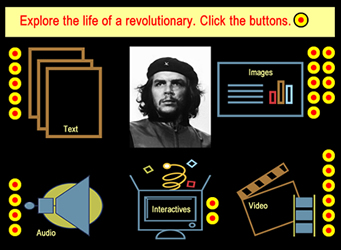
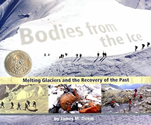 Whole Group. Watch NOVA Ice Mummies program on DVD and explore the
Whole Group. Watch NOVA Ice Mummies program on DVD and explore the 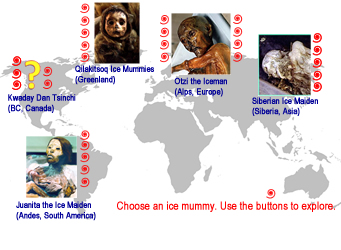
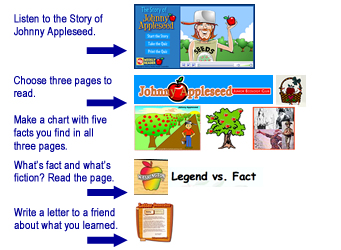
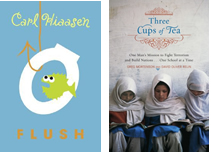 Kevin Hodgson has lots of examples in his
Kevin Hodgson has lots of examples in his